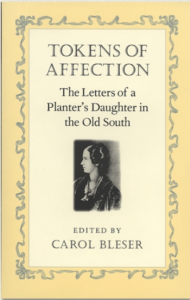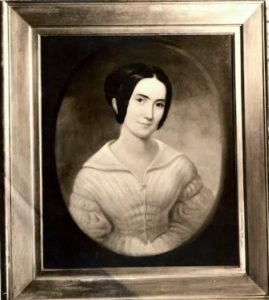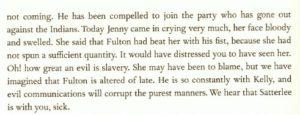 In a letter written to her sister Julia Bryan Cumming, on the night of her nineteenth birthday, Maria Bryan, a planter’s daughter born on New Year’s Day in 1808 at Mt. Zion, Georgia, anticipated the coming year and wondered, “what events it may bring forth.” Maria would go on to write over twenty letters to her sister in 1827 and many more until her untimely death in 1844 at the age of 36. Donated to the South Caroliniana Library in Columbia by her nephew George Shaw Billings, noted journalist and brief managing editor for Life magazine, Maria’s letters are a firsthand account of the daily experiences of a young woman born into the planter aristocracy during the height of cotton production in Hancock County, Georgia. When read in hindsight, Maria’s words pondering the uncertainty of the upcoming year foreshadow the South’s tumultuous and incendiary future, a future Maria never lived to see.
In a letter written to her sister Julia Bryan Cumming, on the night of her nineteenth birthday, Maria Bryan, a planter’s daughter born on New Year’s Day in 1808 at Mt. Zion, Georgia, anticipated the coming year and wondered, “what events it may bring forth.” Maria would go on to write over twenty letters to her sister in 1827 and many more until her untimely death in 1844 at the age of 36. Donated to the South Caroliniana Library in Columbia by her nephew George Shaw Billings, noted journalist and brief managing editor for Life magazine, Maria’s letters are a firsthand account of the daily experiences of a young woman born into the planter aristocracy during the height of cotton production in Hancock County, Georgia. When read in hindsight, Maria’s words pondering the uncertainty of the upcoming year foreshadow the South’s tumultuous and incendiary future, a future Maria never lived to see.
The antebellum South is one of the most studied and written about periods in American history, in particular the institution of American slavery. There is no shortage of first-person accounts in the form of letters, diaries, memoirs and narratives that have been used by scholars and historians to understand this peculiar moment in history. When studied alongside other primary sources, Maria’s letters, like those written by other antebellum women, such as Mary Chestnut and Ella Gertrude Clanton Thomas, offer a singular perspective of a life lived in opulent wealth at the expense of enslaved human beings. Both Chestnut and Clanton Thomas lived into the postbellum period, and witnessed firsthand the devastation wrought by the Civil War, but Maria Bryan lived and died in a world dictated solely by a slave economy.
The letters are of particular interest to those studying women’s history as well as those interested in finding enslaved ancestors. In several of her letters, Maria wrote of the enslaved human being who worked on her father, Joseph Bryan’s plantation in Hancock County, one of the wealthiest counties in antebellum Georgia. In a particularly heartbreaking letter, written shortly after her sister’s marriage to the son of Augusta’s first mayor, Thomas Cumming, Maria writes of Jenny, an enslaved woman she owned and the beating she received from an overseer because she failed to meet her quota of spinning. Maria laments to her sister, “It would have distressed you to see her face bloody and swelled. Oh how great an evil is slavery.”
It is this letter and others in which the enslaved are named that are of particular interest to staff of the Georgia Heritage Room, given a special primary source we have in our own collection. In 1966, Patrick D. Walsh, nephew of politician Patrick Walsh, who served as editor of the Augusta Chronicle from 1875 until his death in 1899, donated a rather interesting document to the Augusta Public Library. The details of the donation have been lost to time, and the how’s and why’s of Walsh’s ownership of this manuscript are unknown. The manuscript is deed of trust established on April 11, 1841 between Martha Maria Harford (Maria Bryan) and her father Joseph Bryan, granting ownership of five enslaved individuals to her father. The deed stipulates that Maria retains rights over them, and that her father shall manage them for her benefit. Digging a little deeper into Maria’s life and letters, we learn that she married her second husband Dr. Alva Connell on April 11, 1841, the same day the deed was established. Living in a world governed exclusively by white men, perhaps Maria was protecting her rights and property by transferring ownership of the enslaved to her father, who held them in trust for her, preventing her future husband’s claim on that property.

Excerpt from Bryan Deed of Trust (1849) naming five enslaved persons. MS 136 Augusta Public Library Georgia Heritage Room
Those named are Matt and Bird, both about twenty-five years old; Jinny, about thirty-five years old; Annette, Jinny’s child; and George who is five years old. We can assume that the Jenny named in the deed is the same Jenny Maria writes about in her letters. Living within an economic system that considered enslaved human beings property, those searching for ancestors prior to the Civil War should understand where to look for information about enslaved family members. This deed of trust is an example of a property record that can provide valuable clues for genealogical research. Once the enslaver is established, the researcher must locate any and all records associated, especially bills of sale, estate and probate records, like wills and administration papers, and in this case, deeds of trust are another avenue of inquiry.
Both women and enslaved African-Americans of the antebellum South found themselves at the mercy of a system that denied them civil rights, and for the enslaved, basic human rights. Both had to learn to exist within the parameters of this brutal system, to live by their own volition within a system that worked to totally deny them that freedom. The deed of trust between Maria Bryan and her father is one example of how a woman could legally manipulate a male dominated system to her advantage. By signing over ownership of her enslaved men and women to her father, but retaining all rights of their service, Maria prevented her new husband from having any legal control of her “property.” And yet, Jenny, Annette, Matt, Bird, and little George were given no say in the matter. Though Maria did express remorse when Jenny was brutally beaten, ultimately she considered the slaves chattel to be leveraged for her financial benefit. Naming them in the deed however means they are not lost to history and boldly stand out for their descendants to find. They just need to know where to look.
February and March are nationally designated months set aside to honor both African American history and women’s history respectively. During this time, Georgia Heritage Room staff will be highlighting ARCPLS collections, like the deed of trust, that shine a light on both. Stay tuned!


